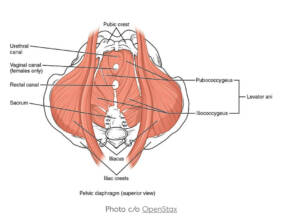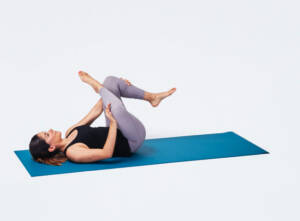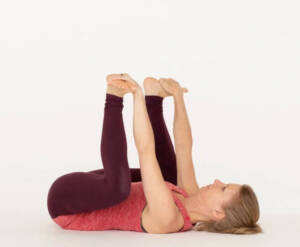After childbirth, it’s become more common to think about the strength of your pelvic floor. After all, the pelvic floor, the muscles that hold up the contents of your pelvis and have been working overtime for nine months. But this work can lead to weak pelvic floor muscles and also tight pelvic floor muscles which can be just as problematic—especially in runners.
Weak pelvic floor muscles and tight pelvic floor muscles often present the same and can lead to pelvic pain and the same type of running injuries such as to the low back, groin, knee hips, and hamstrings.

But the way you treat weak pelvic floor muscles and tight pelvic floor muscles is very different. Most people still assume that the way to fix pelvic pain and a pelvic area issue is doing Kegels, an exercise in which you clench your pelvic floor and hold.
The Problem with a Tight Pelvic Floor
But when your pelvic floor is too tight, aka a hypertonic pelvic floor, you want them to relax. Being too tight erodes the strength, flexibility, and coordination of the pelvic floor so that it can’t do its job effectively.
Because the pelvic floor is involved in every step we take, having a nonrelaxing pelvic floor dysfunction can change the way your body moves. But it’s fixable! And I will share how to relax your pelvic area.
In this article, I got with Dr. Amanda Olson, president and chief clinical officer of Intimate Rose, which sells pelvic health products. I will cover the following questions related to having tight pelvic floor muscles:
- What is a tight pelvic floor?
- Why is having a tight pelvic floor bad for runners?
- What causes a tight pelvic floor?
- What are the symptoms of a tight pelvic floor?
- How can you loosen a tight pelvic floor?
- At-home exercises to correct a tight pelvic floor, plus
- How to find a pelvic floor physical therapist.
This article is not meant to diagnose or treat a tight pelvic floor. It is meant to help you determine if you need help with your pelvic floor health and what to expect with a pelvic floor physical therapist.
Related: Should I See a Pelvic Floor Specialist?
What is a tight pelvic floor?

Your pelvic floor is the group of muscles that form a sling at the bottom of your pelvic bowl.
These muscles are a crucial part of your core and work in collaboration with your abs and are involved in every step you take.
When the pelvic floor muscles are too tight, it often indicates that they are “overactive,” explains Dr. Olson. This means that they do not know how to turn off or relax when it is appropriate to do so.
Healthy pelvic floor muscle function requires these muscles to be both strong and flexible and have good timing and coordination.
“When the pelvic floor muscles are too tight, they lack the flexibility or the coordination to relax to allow for activities such as bowel movements, and in some cases intercourse,” says Dr. Olson.
Related: Can You Run a Marathon Pregnant?
Why is having a tight pelvic floor bad for runners?

Running introduces multiple times the runner’s body weight into each leg for every stride, explains Dr. Olson. This impact travels from the foot at contact and resonates into the pelvis.
Thus, if the pelvic floor muscles are too tight it can result in some of the following running injuries and issues:
- pelvic pain
- back pain
- change in running gait mechanics
- hip pain and
- knee pain
This is due to poor timing of the hip muscles which share a fascial plane with the pelvic floor, and incontinence.
The stiffness of the pelvic floor muscles can also lead to the leaking of urine. (It is important to know that the opposite can also be true- if the pelvic floor muscles are too weak, urinary incontinence can also occur).
You can read more about how to stop leaking when running here.
Related: How the Pros Return to Running Postpartum
What are the symptoms of a tight pelvic floor?
Symptoms of a tight pelvic floor include but are not limited to:
- constipation
- pelvic pain
- pain with intercourse
- difficulty using a tampon
- difficulty receiving a gynecological exam
- deep hip pain that you cannot reach or stretch
- bladder pain
- pubic pain
- low back pain
- tailbone pain
- and in some cases urinary incontinence
What causes a tight pelvic floor?
People of all ages and genders can experience a hypertonic pelvic floor. However, it is fairly common to have an overactive pelvic floor after childbirth, particularly if you had a childbirth injury such as a perineal tear or episiotomy, and in some cases, a C-section.
A C-section can result in a guarding reflex of gripping or clenching the pelvic floor muscles, which when done habitually can lead to them becoming too tight, says Dr. Olson.
It can also happen later after childbirth as a guarding reflex due to stress (similar to jaw clenching), or a means of attempting to manage incontinence.
Related: The Best Belly Bands for Pregnant Runners
Will a tight pelvic floor relax on its own?

No. An overactive pelvic floor will not relax on its own.
This is because tight pelvic floor muscles result in a habitual pattern over time, explains Dr. Olson. Thus, the condition requires addressing not only the muscle itself but the coordination and brain-pelvic floor activation patterns to contract when it’s appropriate and relax when necessary.
This is where exercises like the ones below and interventions directed by a pelvic floor physical therapist can help.
Related: Pregnancy Ab Exercises
How do you loosen tight pelvic floor muscles?
The good news is that just like any other group of muscles, too tight pelvic floor muscles can be re-trained to have better flexibility and to be well coordinated, says Dr. Olson.
While the advice here gives you an idea of how to fix tight pelvic floor muscles, treatment of chronic pelvic pain should begin with a thorough examination by a well-trained pelvic health physical therapist.
In this exam, the pelvic PT will ask questions about your gynecological and other medical history and will take a close look at how your back, hips, and pelvis are functioning. They will assess scar tissue and will perform a brief vaginal examination to determine if you have trigger points, adhesions, or scar tissue in your pelvic floor muscles.
A pelvic PT will analyze the pelvic muscle tone, and how well the muscles can contract and relax.

Related: Your Complete Postpartum Running Guide
Treatments include:
- gentle manual therapy to address trigger points in the pelvic floor
- biofeedback to retrain the muscles in how to contract and relax on command
- using the Intimate Rose Pelvic Wand at-home which relieves trigger points in the pelvic floor muscles,
- and performing pelvic floor release stretches and exercises such as the ones below.
3 At-home Exercises to Relax a Tight Pelvic Floor
While doing these exercises, practice diaphragmatic breathing which will help you relax:
- Before beginning the stretches, breathe through your nose comfortably into your tummy.
- Place your hand on your belly button to feel the air fill your tummy and it rise and fall.
- Briefly pause before exhaling through your mouth.
- Notice your body relaxing and calming with each breath.
- Repeat at least 5 cycles of breath before beginning.
Related: How to Breathe When You Run
Use a mat or soft surfaces for these exercises:
Lying Hip Flexor Stretch

- Lie on your back with a neutral spine with your knees bent and feet flat on the floor.
- Bend your right knee until the thigh is perpendicular to the floor.
- Bring your left knee up, rotating your left leg outward at the hip so that you can rest your left ankle on top of your right thigh, above the knee.
- Take your right hand to the outside of the right thigh. Thread your left hand through the opening of bent left leg has made. Grasp your hands behind the right thigh.
- Press your left thigh open with your left elbow as you pull your right thigh toward your chest with your hands.
- You should feel a stretch on your left hip.
- Breathe deeply into the stretch.
- Hold for 30 seconds.
- Repeat on the other side.
Happy Baby Pose

- Lie flat on your back on the floor with your knees bent close to your chest and your feet towards the ceiling.
- Grab your feet so that you are holding the outside of them and can spread your knees apart, moving them towards your armpits.
- Flex your heels into your hands and gently rock from side to side.
- Breathe deeply and hold for 30 seconds.
Child’s pose
- Lying on your stomach with your forehead resting on the floor, spread your knees wide to the edges of your mat.
- Keep the tops of your feet on the floor with your big toes touching.
- Have your tummy rest in between your thighs. Relax the shoulders, jaw, neck, and eyes.
- Root your forehead on the ground. This stimulates the vagus nerve and the “rest and digest response.” Lightly turn your head from side to side if it feels good.

View Dr. Olson’s pelvic floor relaxation guide here for a demo.
Related: Is Yoga Good for Runners?
How can I find a pelvic floor physical therapist?
It is important to see a pelvic PT for a thorough examination to determine which classification the pelvic floor muscles are in. Some people can determine it based on the presentation of the signs and symptoms listed above, but ultimately a diagnosis should be made by a skilled professional.
There are several ways to find a pelvic floor specialist near you:
- Do a google search for someone local to you
- Ask other mothers or your OB
- Search databases such as:Pelvic Rehab, APTA Pelvic Health and Pelvic Guru
- Connect with one virtually like Hannah Poe or Dr. Carrie Pagliano (who has also provided information for my articles).
If you want guidance with your training, including returning to running after pregnancy, check out my run coaching services. Also, be sure to check out my free training plans:
- Postpartum Training Plan
- After a Break Training Plan
- 5k Training Plans
- 10k Training Plans
- Half Marathon Training Plans
- Marathon Training Plans
- Strength Training Plan
